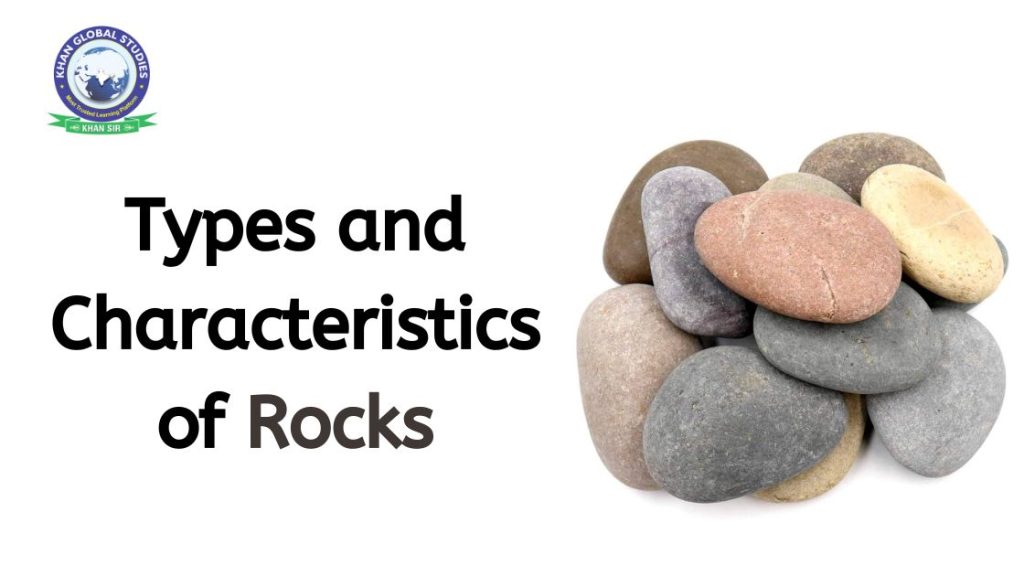Rocks are naturally occurring solid aggregates of one or more minerals. They are the foundation of our planet and play an important role in the biogeochemical cycles that sustain life. Rocks can be classified into three main types: igneous, sedimentary, and metamorphic. Each type of rock has its unique characteristics formed by the processes that created it.
Types of Rocks
Igneous Rocks
Igneous rocks are formed from the cooling and solidification of magma or lava. Magma is molten rock that forms deep within the Earth’s crust, while lava is molten rock that erupts onto the surface. Igneous rocks can be further classified into two main types: intrusive and extrusive.
- Intrusive igneous rocks are formed when magma cools and solidifies below the Earth’s surface. These rocks are often coarse-grained, meaning that they have large crystals. This is because the magma cools slowly underground, allowing the crystals to grow large. Examples of intrusive igneous rocks include granite, diorite, and gabbro.
- Extrusive igneous rocks are formed when lava cools and solidifies on the Earth’s surface. These rocks are often fine-grained, meaning that they have small crystals. This is because the lava cools quickly at the surface, preventing the crystals from growing large. Examples of extrusive igneous rocks include basalt, andesite, and rhyolite.
Sedimentary Rocks
Sedimentary rocks are formed from the accumulation and compaction of sediments. Sediments are fragments of rock, mineral, or organic matter that have been transported from their original location by wind, water, or ice. When sediments are buried, they are compacted and cemented together to form sedimentary rock. Sedimentary rocks can be classified into three main types: clastic, chemical, and organic.
- Clastic sedimentary rocks are formed from the accumulation of clastic sediments. Clastic sediments are fragments of rock, mineral, or organic matter that have been broken down by weathering and erosion. Examples of clastic sedimentary rocks include sandstone, shale, and conglomerate.
- Chemical sedimentary rocks are formed from the precipitation of minerals from solution. When minerals dissolve in water, they can be transported to new locations. When the water evaporates, the minerals can precipitate out of solution and form chemical sedimentary rocks. Examples of chemical sedimentary rocks include limestone, dolomite, and rock salt.
- Organic sedimentary rocks are formed from the accumulation of organic matter. Organic matter is the remains of dead plants and animals. When organic matter is buried, it can be compacted and transformed into organic sedimentary rocks. Examples of organic sedimentary rocks include coal and oil shale.
Metamorphic Rocks
Metamorphic rocks are formed from the transformation of existing rocks. This transformation can be caused by heat, pressure, or a combination of both. Heat and pressure can cause the minerals in a rock to recrystallize, forming new minerals. They can also cause the rock to deform, changing its shape and texture. Metamorphic rocks can be classified into two main types: foliated and non-foliated.
- Foliated metamorphic rocks have a banded or layered appearance. This is because the minerals in the rock have been flattened and aligned by pressure. Examples of foliated metamorphic rocks include gneiss, schist, and slate.
- Non-foliated metamorphic rocks do not have a banded or layered appearance. This is because the minerals in the rock have not been flattened or aligned by pressure. Examples of non-foliated metamorphic rocks include marble, quartzite, and soapstone.
Characteristics of Rocks
The characteristics of a rock can be used to identify its type. Some of the most important characteristics of rocks include:
- Mineral composition: The type of minerals that a rock is made up of can be used to identify its type. For example, granite is an igneous rock that is made up of the minerals quartz, feldspar, and mica.
- Texture: The texture of a rock refers to the size, shape, and arrangement of its grains. The texture of a rock can be used to identify its type and how it was formed. For example, granite is an igneous rock that has a coarse-grained texture, while basalt is an igneous rock that has a fine-grained texture.
- Color: The color of a rock can be used to identify its type. However, the color of a rock is not always a reliable indicator of its type, as some rocks can come in a variety of colors.
- Foliation: Foliation is the banding or layering of minerals in a rock. The presence or absence of foliation can be used to identify a rock as metamorphic. Foliated metamorphic rocks, like gneiss and schist, will display this banding due to the pressure that realigned their minerals. Non-foliated metamorphic rocks, like marble and quartzite, won’t exhibit foliation because the pressure didn’t cause such mineral alignment.
Understanding the Rock Cycle
The three main types of rocks – igneous, sedimentary, and metamorphic – are interconnected through the rock cycle. The rock cycle is a continuous process that describes how rocks are formed, weathered, eroded, deposited, and transformed over time.
- Weathering and Erosion: Igneous, sedimentary, and metamorphic rocks can all be broken down by weathering and erosion. Weathering is the process of breaking down rocks by physical, chemical, or biological processes. Erosion is the transport of weathered rock particles by wind, water, or ice.
- Sedimentation: The weathered and eroded rock particles are eventually deposited as sediments. These sediments can be transported long distances before being deposited in layers.
- Lithification: Over time, sediments can be buried and compacted. This compaction, along with the action of water and minerals, can cement the sediments together to form sedimentary rocks.
- Metamorphism: Sedimentary rocks, igneous rocks, or even other metamorphic rocks can be subjected to intense heat and pressure. This heat and pressure can cause the rocks to recrystallize or deform, forming metamorphic rocks.
- Melting: Under extreme heat and pressure, metamorphic rocks or sedimentary rocks can melt and form magma. This magma can then cool and solidify to form new igneous rocks.
The rock cycle is a never-ending process that has been shaping the Earth for billions of years. By understanding the types and characteristics of rocks, and the rock cycle, we can gain a greater appreciation for the complex and dynamic nature of our planet.





